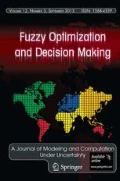Abstract
A new analysis technique, appropriate to situations of high preference uncertainty, is added to the graph model for conflict resolution methodology. Interval fuzzy stabilities are now formulated, based on decision makers’ (DMs’) interval fuzzy preferences over feasible scenarios or states in a conflict. Interval fuzzy stability notions enhance the applicability of the graph model, and generalize its crisp and fuzzy preference-based stability ideas. A graph model is both a formal representation and an analysis procedure for multiple participant-multiple objective decisions that employs stability concepts representing various forms of human behavior under conflict. Defined based on a type-2 fuzzy logic, an interval fuzzy preference for one state over another is represented by a subinterval of [0, 1] indicating an interval-valued preference degree for the first state over the second. The interval fuzzy stabilities put forward in this research are interval fuzzy Nash stability, interval fuzzy general metarational stability, interval fuzzy symmetric metarational stability, and interval fuzzy sequential stability. A state is interval fuzzy stable for a DM if moving to any other state is not adequately desirable to the DM; where adequacy is measured by the interval fuzzy satisficing threshold of the DM and farsightedness, involving possible moves and countermoves by DMs, is determined by the interval fuzzy stability notion selected. Note that infinitely many degrees in an interval-valued preference are preserved in characterizing the desirability of a move. A state from which no DM can move to any sufficiently desirable scenario is an interval fuzzy equilibrium, and is interpreted as a possible resolution of the strategic conflict under study. The new stability concept is illustrated through its application to an environmental conflict that took place in Elmira, Ontario, Canada. Insightful results are identified and discussed.

Similar content being viewed by others
References
Al-Mutairi, M. S., Hipel, K. W., & Kamel, M. S. (2008). Fuzzy preferences in conflicts. Journal of Systems Science and Systems Engineering, 17, 257–276.
Bashar, M. A., Kilgour, D. M., & Hipel, K. W. (2011). Fuzzy preferences in the sustainable development conflict. In Proceedings of the 2011 IEEE international conference on systems, man, and cybernetics, 2011 (pp. 3483–3488).
Bashar, M. A., Kilgour, D. M., & Hipel, K. W. (2012). Fuzzy preferences in the graph model for conflict resolution. IEEE Transactions on Fuzzy Systems, 20(4), 760–770.
Bashar, M. A., Kilgour, D. M., & Hipel, K. W. (2014). Fuzzy option prioritization for the graph model for conflict resolution. Fuzzy Sets and Systems, 246, 34–48.
Bashar, M. A., Obeidi, A., Kilgour, D. M., & Hipel, K. W. (2016). Modeling fuzzy and interval fuzzy preferences within a graph model framework. IEEE Transactions on Fuzzy Systems, 24(4), 765–778.
Fang, L., Hipel, K. W., & Kilgour, D. M. (1993). Interactive decision making: The graph model for conflict resolution. New York: Wiley.
Fraser, N. M., & Hipel, K. W. (1984). Conflict analysis: Models and resolutions. New York: North-Holland.
Gao, J. (2013). Uncertain bimatrix game with applications. Fuzzy Optimization and Decision Making, 12(1), 65–78.
Hipel, K. W. (2009). Conflict resolution: Theme overview paper in conflict resolution. In K. W. Hipel (Eds.). Encyclopedia of Life Support Systems (EOLSS) (Vol. I, pp. 1–31). Oxford: EOLSS Publishers. http://www.eolss.net.
Hipel, K. W., Fang, L., Kilgour, D. M., & Haight, M. (1993). Environmental conflict resolution using the graph model. In Proceedings of the 1993 IEEE international conference on systems, man, and cybernetics, 1993 (pp. 153–158).
Hipel, K. W., Fang, L., & Kilgour, D. M. (2008). Decision support systems in water resources and environmental management. Journal of Hydrologic Engineering, 13(9), 761–770.
Hipel, K. W., & Obeidi, A. (2005). Trade versus the environment: Strategic settlement from a systems engineering perspective. Systems Engineering, 8(3), 211–233.
Howard, N. (1971). Paradoxes of rationality: Theory of metagames and political behavior. Cambridge, MA: MIT Press.
Howard, N. (1999). Confrontation analysis: How to win operations other than war. The Pentagon, Washington, DC: DoD C4ISR Cooperative Research Program.
Kilgour, D. M., & Eden, C. (Eds.). (2010). Handbook of group decision and negotiation. New York: Springer.
Kilgour, D. M., & Hipel, K. W. (2005). The graph model for conflict resolution: Past, present, and future. Group Decision and Negotiation, 14(6), 441–460.
Kilgour, D. M., Hipel, K. W., & Fang, L. (1987). The graph model for conflicts. Automatica, 23(1), 41–55.
Kuang, H., Bashar, M. A., Hipel, K. W., & Kilgour, D. M. (2015). Grey-based preference in a graph model for conflict resolution with multiple decision makers. IEEE Transactions on Systems, Man, and Cybernetics: Systems, 45(9), 1254–1267.
Li, K. W., Hipel, K. W., Kilgour, D. M., & Fang, L. (2004). Preference uncertainty in the graph model for conflict resolution. IEEE Transactions on Systems, Man, and Cybernetics-Part A: Systems and Humans, 34(4), 507–520.
Nurmi, H. (1981). Approaches to collective decision making with fuzzy preference relations. Fuzzy Sets and Systems, 6, 249–259.
Rego, L. C., & dos Santos, A. M. (2015). Probabilistic preferences in the graph model for conflict resolution. IEEE Transactions on Systems, Man, and Cybernetics: Systems, 45(4), 595–608.
von Neumann, J., & Morgenstern, O. (1944). Theory of games and economic behavior. Princeton: Princeton University Press.
Xu, Z. S. (2004). On compatibility of interval fuzzy preference relations. Fuzzy Optimization and Decision Making, 3, 217–225.
Xu, Z. S. (2007). A survey of preference relations. International Journal of General Systems, 36, 179–203.
Zadeh, L. A. (1965). Fuzzy sets. Information and Control, 8, 338–353.
Acknowledgements
The authors appreciate receiving helpful advice from anonymous referees which improved the quality of their paper. They also would like to express their appreciation to Prof. Ni-Bin Chang of the University of Central Florida for suggesting that they incorporate interval fuzzy preference into the GMCR methodology. The first author is grateful to the Natural Sciences and Engineering Research Council of Canada (NSERC) for financial support from NSERC Discovery grants.
Author information
Authors and Affiliations
Corresponding author
Rights and permissions
About this article
Cite this article
Bashar, M.A., Hipel, K.W., Kilgour, D.M. et al. Interval fuzzy preferences in the graph model for conflict resolution. Fuzzy Optim Decis Making 17, 287–315 (2018). https://doi.org/10.1007/s10700-017-9279-7
Published:
Issue Date:
DOI: https://doi.org/10.1007/s10700-017-9279-7




